
Table of Contents
Technology enthusiasts are confident that quantum computing will revolutionize every single field: With its applicability and forecasted capabilities in almost all aspects of science such as drug discovery and pharmaceuticals, IT security and cryptology, material and computational chemistry, and meteorology among others, it has attracted VC funding of well over USD 1 billion.
With the help of a quantum system, a user can complete a certain number of tasks much faster than completing such tasks with a classical system.
Nonetheless, those invested in cryptocurrency are wary of the potential harm quantum computing poses to cryptocurrency despite the benefits it can deliver to other industries.
QR Ledger is not just a Quantum computing-resistant ledger, it has attributes that position it exceptionally well for resilience and indeed prosperity in a quantum world.
But there are more developments in the offing. QRL is set for a Proof-of-Stake (POS) network which is still under construction with the network expected to be deployed in the early part of Q1 of 2025.
Not only will this result in a more efficient and “greener” network, but it also means that the supposedly effective 51% attack (common to the Proof-of-Work blockchain) becomes much more unrealistic.
As a result of this, it is a brand new POS network accompanied by a significant overhaul – the new network will be EVM compliant. It is implied that any token presently existing on the currently quantum-vulnerable Ethereum chain (in most cases an ERC20 token) can be cloned on the QRL chain.
At the same time, the potential threat of quantum computing can be completely negated in a stroke.
Quantum currencies are defined as new monetary systems that predominantly differ from the known cryptocurrencies –they are a safe system of value transfer. This in my opinion could be the beginning of the quantum financial systems taking over the central banking system.
It is possible to construct quantum cryptography using post-quantum cryptographic signatures.
Advanced digital signatures form hash-based signatures, code-based signatures, Lattice-based signatures, and multivariate quadratic equations little in combination with secret key cryptography.
Quantum cryptographic blockchain technology using pqcrypto endorsed by NIST is utilized in the first industrial implementation of a quantum-resistant ledger (QRL).
It employs a hash-based digital signature, the extremely Scalable Merkle Tree Signature (XMSS), in place of the Elliptic Curve Digital Signature Algorithm (ECDSA) that is applied in normal cryptocurrencies.
This enables the users to interact with both public and private post-quantum blockchains that are established at the core of the company.
Component of Quantum-Resistant Ledger
- An origin authentication scheme is known as a one-time signature scheme (OTS).
- A technique for generating a single global public key, while using a large number of OTS’s public keys.
Uniqueness of Quantum-Resistant Ledger
- It has been operating a Proof-of-Work mainnet since June of the year 2018.
- It uses verifiably quantum-secure and recommended Xtended Merkel-tree Signature Scheme (XMSS)
- Open-Source
- MIT Licensed
- It is inherently future-proofed by crypto agility
Importance of QRL
- Stored digital assets will be protected against cyber threats by the QRL, which also facilitates the ability to transact with post-quantum blockchains. QRL is made secure for the present and future quantum computer era by the post-quantum secure digital signature, XMSS.
- The set of products in the platform ranges from developers, ordinary users, and even data miners and analysts. It runs on Mac, Windows, as well as Linux and has iOS and Android mobile apps. It also provides web browsers that can be downloaded from its website for use. Environment developers can develop quantum-safe blockchain applications that cannot be attacked by quantum computers using the rich API, an open development infrastructure, and open algorithms.
Security in QRL
How people use ledger to store and transfer value has been changed by digital ledgers, especially blockchain technology.
It is believed that blockchain offers a decentralized and secure record of transactional history that provides improvements in the enterprise of security and credibility in digital contexts.
However, these systems are posed with a strong threat by a new block in cryptography called quantum computing.
A QRL is built to prevent quasi-time attacks from future quantum computers hence transaction safety is insisted upon. This protection is considered critical for several reasons:
Financial security: In the modern world of rapidly developing digital business, secure records in financial transactions play an important role.
Not only transactional transactions, but also the overall financial system could be threatened by an attack at the quantum level.
Data integrity: Contracts, identities, and trademarks are uploaded in most blocks that are reported to be digital ledgers. In this case, unauthorized access, manipulation, or theft of this information may likely result from quantum attacks.
Trust in decentralized systems: Cryptographic security is used in the decentralized form of blockchain. If the security of these systems can be compromised by quantum computers with such ease, people could be pushed away from such systems, thereby hampering the expansion of such systems in the market.
